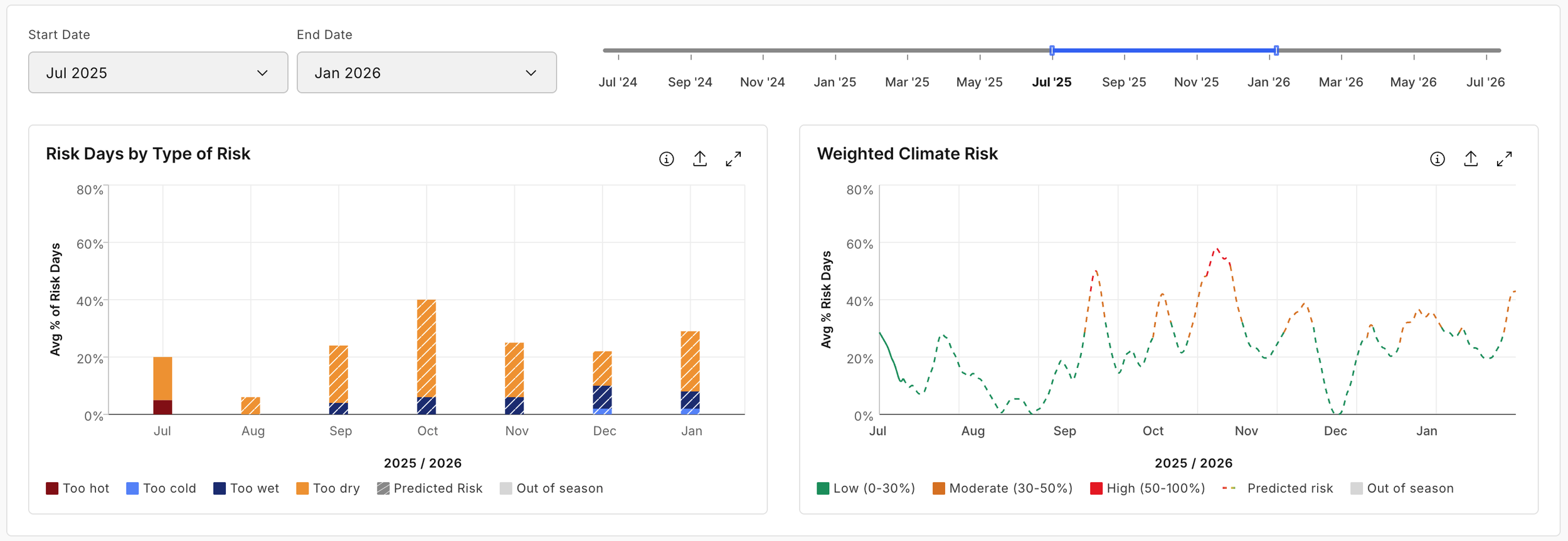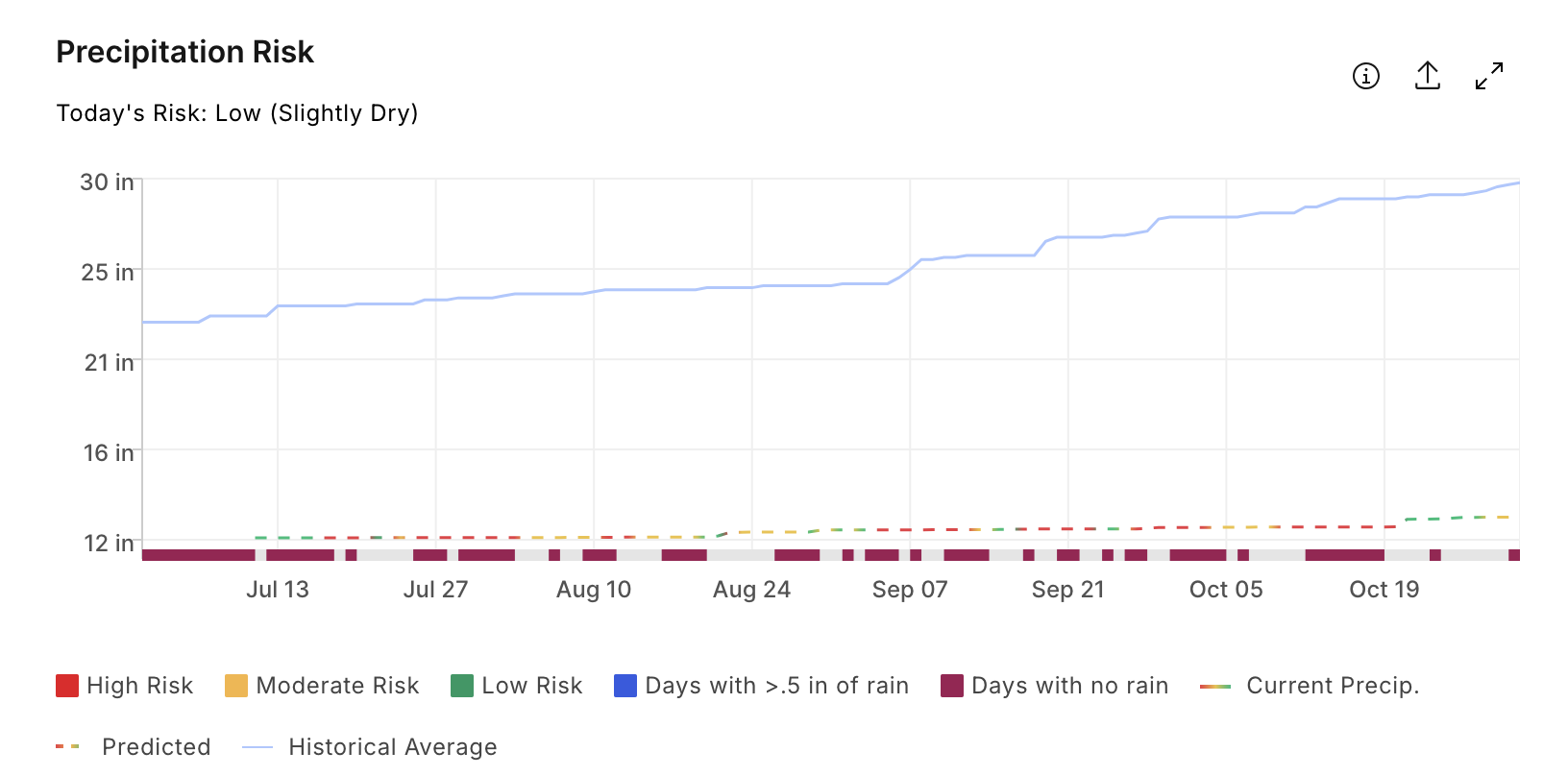A Climate Challenge in the Heart of the Mediterranean
Olive oil isn’t just an export for Greece—it’s a staple of daily life, a rural economic engine, and a symbol of cultural identity. But today, Greek producers are grappling with one of the worst harvests in recent memory. Heatwaves, drought, and pests have slashed yields and pushed prices to painful highs.
This isn’t only Greece’s problem. It’s a preview of what climate change means for crops that depend on stable, predictable weather. And while farmers can’t change the climate, they can make better decisions when they understand the risks they face.
A Tough Season for Greek Producers
Over the 2023/24 harvest, Greece’s olive oil production dropped to its lowest level in six years, falling to around 150,000–170,000 tons, with some regions losing up to 70% of their typical yield. Farmers faced an unforgiving mix of severe drought, scorching summer heat, and warmer-than-usual winters that allowed the destructive olive fruit fly to flourish. The result was not only fewer olives but smaller, lower-quality fruit with less oil content. The reduced supply led to a surge in olive oil prices. Producer prices for extra virgin olive oil in Greece nearly halved from the previous year's peak of €9-10 per kilogram to around €4.80-€5.30 per kilogram. However, retail prices remained high, ranging from €11.50 to €14 per liter, leading to concerns about profiteering and price speculation. While producer prices have shown signs of easing, consumers haven't felt much relief, with high costs straining household budgets and driving up overall food inflation.
The soaring value of olive oil has also led to increased reports of theft, from small-scale orchard raids to large-scale heists targeting storage facilities, adding another layer of stress for producers already grappling with a difficult season.
Signs of a Recovery, but Risks Remain
There’s cautious optimism for the 2024/25 season. Early forecasts suggest Greece’s production could rebound to 220,000–230,000 tons if weather conditions improve. But that’s a big “if.” The industry remains highly vulnerable to shifting climate patterns. Even a single season of extreme heat or poor rainfall can slash yields and send prices surging again. For growers who rely on olives for their livelihoods, that uncertainty makes planning difficult and risky.
Helios’s model shows continued low rainfall risk with only slight improvements ahead. This dry outlook signals tight soil moisture and a continued issue with drought. Our model also reveals sharp swings between low and high climate risk days. This volatility adds uncertainty to supply forecasts.
Overall, it’s not looking fantastic, but I wouldn’t throw in the towel just yet. Greece’s season climate risk rating for Olives is rated “Fair” at 2/5 stars. This means crop production and/or yield will likely be slightly negatively impacted, with a chance of a price increase due to climate conditions. Our yield rating is “Neutral” overall, with this season rated as most similar to the growing season of 2016. Certain locations are expected to perform better than others - Heraklion and Larissa have a “good” rating for the season. Other locations, however, are expected to perform worse than others, such as Corfu, Corinthia and Laconia, with a “poor” rating. This varies quite a bit, so I’d take a look at where exactly you are sourcing olive oil from before drawing any concrete conclusions.
Greece’s risk charts depict an overall continuation of drought, with some areas getting relief through rain. Risk looks highest in late October.
A Broader Mediterranean Challenge
Greece isn’t alone. Spain, Italy, and Tunisia, other major producers, have faced similar crises in recent years, with drought, heatwaves, and pests disrupting harvests and tightening global supplies (Bloomberg).
These problems underscore that olive cultivation depends on a delicate balance of seasonal cues that climate change is disrupting. Warmer winters let pests survive. Unpredictable rainfall stresses trees. Intense summer heat damages fruit. This is the new reality growers are trying to navigate—not just in Greece, but across the Mediterranean.
How Helios Can Help Procurement Teams Navigate Change
Manufacturers, retailers, and distributors can’t control droughts or heatwaves. But they can prepare for them with the right information. That’s where Helios comes in.
Laconia, Peloponnese’s precipitation estimate for the next few months - as you can see, the drought is expected to continue.
Helios helps procurement teams understand where climate risks are most likely to disrupt supply. By identifying regions facing higher drought risk in the coming season, buyers can evaluate sourcing strategies, diversify suppliers, or adjust inventory planning in advance. Tracking local temperature trends allows Helios to highlight areas with increased pest pressures, like outbreaks of the olive fruit fly, so teams can anticipate potential quality or volume issues before they hit contracts.
Our models also provide yield risk estimates across regions, giving procurement leaders a clearer picture of price volatility and helping them plan negotiations, contracts, and budgets with better confidence. Instead of reacting to sudden supply shortages or price spikes, procurement teams can use Helios’s localized forecasts and climate scenarios to build more resilient sourcing strategies.
By turning complex climate data into clear, actionable insights, Helios empowers procurement professionals to reduce uncertainty, make informed decisions, and protect the continuity of their supply chains—even as climate conditions become less predictable.
Looking Forward
Greece’s olive oil crisis is a clear warning that climate change isn’t some far-off threat. It’s here, reshaping agriculture right now. While no single solution will erase the risks, better climate intelligence can help farmers plan for them, adapt to them, and keep this essential crop viable for the next generation.
At Helios, we believe that understanding risk is the first step toward building resilience. Our goal is to support the people who grow the food we rely on—giving them the information they need to keep producing, even in a changing world.


